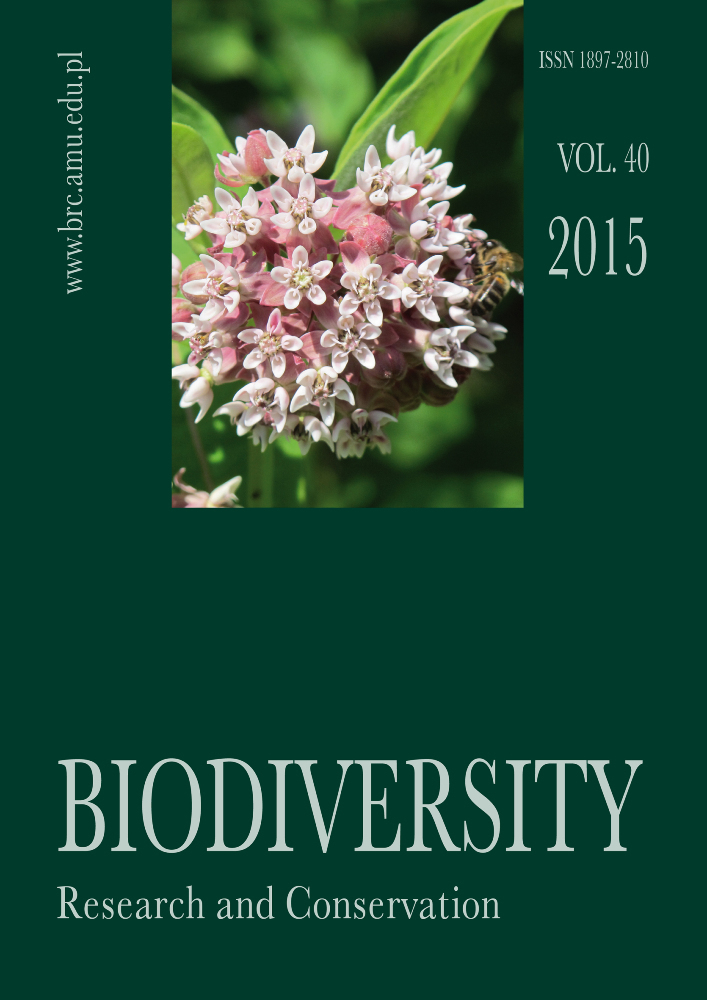Abstract
The paper presents the distribution of 10 selected invasive plant species in Ukraine. The studied taxa comprised 8 invasive and 2 potentially invasive species. All species were characterized in phytogeographical, biological and ecological terms. Their distribution was shown on grid maps.
References
Baldacchino A. E. & Pizzuto A. (eds.). 1996. Introduction of alien species of flora and fauna. Proceedings of Seminar held at Qawra, Malta, 5th March 1996, p. 77. Malta: EPD-Floriana.
Belgard A. L. 1971. Steppe Forestry. 336 pp. Forest industries, Moscow.
Blume H.-P. & Sukopp H. 1976. Ökologische Bedeutung anthropogener Bodenveränderungen, Schriftenreihe für Vegetationskunde, 10: 75-89.
Budzhak V. V. & Dvirna T. S. 2014. Mapping of alien plant species of Romens-Poltava geobotanic area. Biol. syst. 6(1): 78-81.
Costea M., Weaver S. & Tardif F. J. 2004. The biology of Canadian weeds. 130. Amaranthus retroflexus L., A. powellii S. Watson and A. hybridus L. Can. J. Plant Sci. 84: 631-668.
Davis M. 2003. Biotic Globalization: does competition from introduced species threaten biodiversity? BioScience 53: 481-489.
Dvirna T. S. 2014. The alien fraction of the flora of the Romensko- Poltavsky Geobotanical District: an analysis and checklist. Phytodiver. of Eastern. Eur. 8(1): 4-19.
Didukh Y. P., Fitsailo T. V., Korotchenko I. A., Iakushenko D. M. & Pashkevych N. A. 2011. Biotopes of Forest and Forest-Steppe zones of Ukraine. 288 pp. Kiev.
Frankton C. & Mulligan G. A. 1987. Weeds of Canada. 217 pp. Toronto, Ministry of Suppl. Serv, Canada. NC Press Ltd.
Harnett D. C. & Bazzaz F. A. 1983. Phytosociological integration among interclonal ramets in Solidago canadensis. Ecology 64(4): 779-788.
Ilichevs’kyj S. O. 1928. Vegetation of Poltava vicinity. Notes of the Poltava’s agricultural polytechnic college 11: 101-127.
Jackson R. C. 1960. A revision of genus Iva. Univ. Kansas Sci. Bull. 41: 793-876.
Jalas J. 1955. Hemerobe und hemerochore Pflanzenarten. Ein terminologischer Reformversuch. Acta Societatia Pro Fauna et Flora Fennica 72: 1-15.
Kleopov Ju. D. 1990. Analysis of the flora broadleaf forests in the European part of the USSR. 350 pp. Naukova dymka Press, Kiev.
Kornaś J. 1968. Geograficzno-historyczna klasyfikacja roślin synantropijnych. Mater. Zakł. Foitosoc. Stos. U.W. 25: 33-41.
Marjushkina V. Ya. 1986. Ambrosia artemisiifolia and the basics of biological control. 120 pp. Naukova dymka Press, Kiev.
Ojcius L. & Kostolovych M. 2014. Invasive plants the alien fraction flora of Volyn Polessey. Visnyk of the Lviv Univ. Series Geography. 45: 430-435.
Payne W. W. 1966. Notes on the ragweeds of South America with the description of two new species: Ambrosia pannosa and A. parvifolia (Compositae). Brittonia 18: 28-37.
Phisjnov A. V., Makodzeba I. A., Kozenko V. K. & Shamkuy I. F. 1970. The quarantine weeds and their control. 150 pp. Promin Press, Dnepropetrovsk
Pringle J. S. 2010. Nomenclature of the thicket creeper, Parthenocissus inserta ( Vitaceae). The Michigan botanist 49: 73-78.
Protopopova V. V. 1991. Synanthropic flora of Ukraine and ways of its development. 204 pp. Naukova dumka Press, Kiev.
Protopopova V. V., Mosyakin S. L. & Shevera M. V. 2002. Plant invasions in Ukraine as a threat to biodiversity: The present situation and tasks for the future. 32 pp. M. G. Kholodny Institute of Botany, NAS of Ukraine, Kiev.
Protopopova V. V., Mosyakin S. L. & Shevera M. V. 2003. Impact of alien plant species on the phytobiota of Ukraine. In: O. V. Dudkin (ed.). Assessment and Mitigation of Threats to Biodiversity of Ukraine, pp. 129-155. Chimjest. Publ., Kiev.
Raunkiaer C. 1934. The life form of plants and statistical plant geography. 632 pp. Claredon, Oxford.
Richardson D. N., Pyšek P., Rejmánek M., Barbour M. G., Panneta D. D. & West C. J. 2000. Naturalization and invasion of alien plants: concepts and definitions. Diversity Distrib. 6: 93-107.
Rogovych A. S. 1869. Review of the seed and high spore plants that make up the flora of the provinces in Kiev educational district: Volyn, Podolia, Kiev, Chernigov and Poltava. 269 pp. Kiev.
Sax D. F. & Gaines S. D. 2003. Species diversity: From global decreases to local increases. Trends Ecol Evol 18: 541-545.
Serebryakov I. G. 1962. The ecological morphology of plants. Life forms of angiosperms and gymnosperms. 379 pp. Vischaya shkola Press, Moscow.
Schmalhauzen I. F. 1886. Flora oh the South-West Russian. 783 pp. Kiev.
Tolmachev A. I. 1974. Introduction in the geography of plants. 244 pp. Leningrad State University Press, Leningrad.
Tolmachev A. I. 1986. Methods of comparative floristics and problems of florogenesis. 196 pp. Nauka, Novosibirsk.
Vinogradova J. K., Mayorov S. R. & Khorun L. V. 2010. Black book of flora of Middle Russia: alien plant species in the ecosystems of Middle Russia. 512 pp. GEOS, Moscow.
Weaver S. 2001. The biology of Canadian weeds. 115. Conyza canadensis. Canad. J. Plant. Sci. 81 (4): 867-875.
Weber E. 1998. The dynamics of plant invasions: A case study of three exotic goldenrod species (Solidago L.) in Europe. J. Biogeogr. 25: 147-154.




